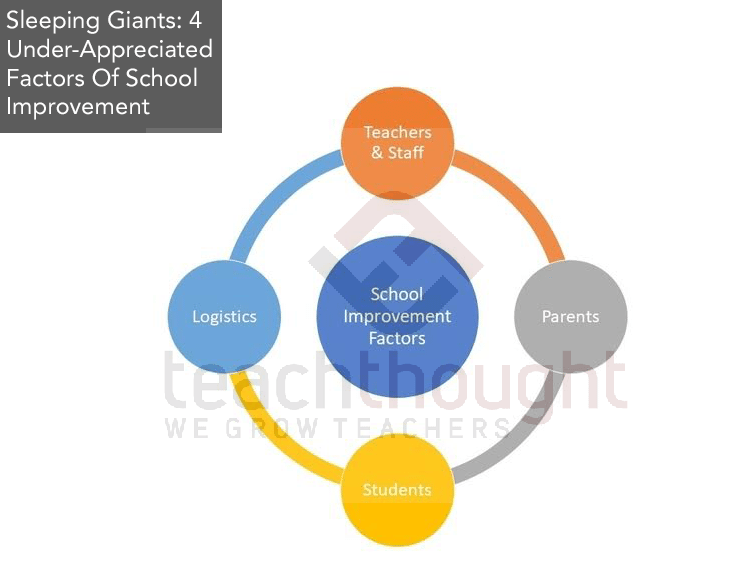
What Are The Under-Appreciated Factors Of School Improvement?
contributed by Aaron Smith
America’s public schools are flawed in many ways, not the least of which are impossible expectations are placed on students and staff.
High-stakes standardized tests, coupled with uncooperative parents with the expectation of doing more with less deter the brightest and most experienced educators to solve the complex issues our youth experience every day.
Instead of teaming together for the common goal, we defer our responsibility to social media, society and our streets to develop our most precious resource. When these elements are misused, they create the perfect storm.
Every year thousands of students end up in one or more of these categories: jail, pregnant, dropping out, gangs or dead. This vicious cycle will only get worse until a national catastrophe occurs unless someone else changes this concept of thinking.
The general mission of most modern schools is simple: Students will go to college, enlist in the military or find a job after graduation. To fulfill school’s purpose, we must remove all obstacles and excuses so the essence of education will thrive once again.
Help teachers teach, allow students to explore, use the most sophisticated technology and the best resources available, so everyone succeeds. The result will not only produce a highly functioning graduate but hope. If and when our children graduate with the skills and competency ready for the workforce, crime statistics reduce, and higher paying wages replace those in poverty and unemployment.
The time is here. The time is now. Be the change. Give all schools the autonomy to make all children succeed. For when schools possess this power, it will change the course of a child and will also prosperously influence communities, corporations and the economy.
To build the perfect public school, we must revamp four critical components: Parents, students, teachers and staff and logistics.
Sleeping Giants: 4 Under-Appreciated Factors Of School Improvement
1. Parents
Parents must be active stakeholders in this transformation. Without them, the learning that has taken place in class otherwise becomes a moot point. At home, students are reinforcing not only favorable characteristics such as manners, responsibility, and self-esteem but ensure that the well-being of a child maximizes their potential.
At home, parents and guardians should listen and follow the recommendations of the teachers and staff with a direct connection with their child. Whether they are just sitting down with them and checking their homework or communication with the school, every part at home is just as important as the lessons at school.
2. Students
Research has shown that when students are engaged in active learning, their academics reflect higher grades. To make this happen, students must overhaul what has become a norm today.
It begins with their appearance. Students who enter schools sagging or dressed inappropriately create distractions. Communication within the school that includes written, spoken and informal should resemble that of a professional setting.
Supplies, assignments and other items are prepared in advance and brought in when requested by the instructor. Social media is checked in at the door and schools are deemed as a bully-free zone. The responsibility of a student lies in their hands and should be only guided by the staff.
3. Teachers & staff
It starts here with finding the teachers who dare students to dream about careers. Time is allotted to students who can pursue an internship and remain in constant contact with parents about their child’s academic progress and their career interests.
Only assess when needed. However, it is essential that data be used periodically to target specific skills missed. Cumulating activities using a rubric can replace standardized testing.
STEM and CTE classes become a cornerstone of all courses and not thought of as an extra resource.
Teachers engage in self-driven professional development and are not wasting time with useless meetings, tasks or other canned professional developments they already know.
The latest technology is incorporated into the classes that facilitate critical thinking.
All lessons encompass around the notion that lessons are student-centered and not teacher lecture-driven.
4. Logistics
Buildings are modern with a fresh and inviting appeal to all who enter the building. After hours, middle and high school students live in dorms where they live distraction free. On the weekends, they can go to their homes or remain in their dorms.
Students can learn more about various cultures where diversity is celebrated. From tasting foods from far away to listening to music from a different country, students will enjoy a positive and nurturing environment.
Inside the schools, students can enter a career corner in the main traffic areas and interact with multiple visitors from professions and schools across the country.
In the dorms and inside the schools, students utilize 3D printer labs, makerspaces, and Smartboards where they can have access to these tools. There students can interact amongst themselves or post a question for staff or others to see and provide the feedback.
Conclusion
Countries like Finland and Japan are already on this new trend but still far from perfect. America has to wipe the slate clean and revamp the whole education system as they have the most resources available to make it happen. Should this initiative take ground, it is most certain that the United States will regain its title as one of the best in the world leading to a promising economic future with bright and hopeful careers for students.
Help us visualize the perfect public school as if we had a blank check. It is in this shared vision where we can effect change. No matter where you are, no matter what you do, you can make a difference! Be the change by getting involved. I invite you to join me on this journey as we can help transform a broken education system into a live and thriving learning center.
Sleeping Giants: 4 Under-Appreciated Factors Of School Improvement
